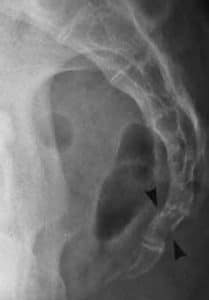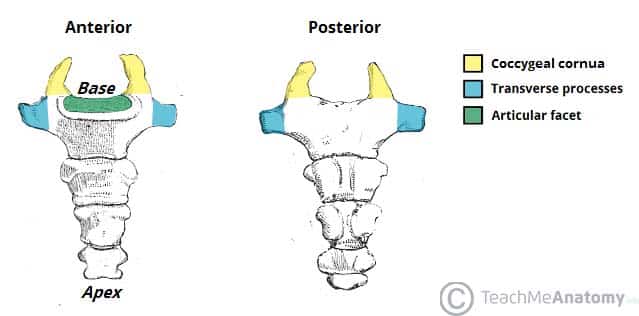The coccyx (also known as the tailbone) is the terminal part of the vertebral column. It is comprised of four vertebrae, which fuse to produce a triangular shape.
In this article, we will discuss the anatomy of the coccyx – its structure, bony landmarks, ligaments and clinical relevance.
Development and Structure
The coccyx arises embryologically as the skeletal remnant of the caudal eminence that is present from weeks 4-8 of gestation. This eminence subsequently regresses, but the coccyx remains. Initially, the four coccygeal vertebrae are separate, but throughout life they fuse together to form one continuous bone.
There is considerable variation in structure between individuals. One common variant is failure of the first coccygeal vertebra (Co1) to fuse, remaining separate throughout adult life. In some individuals, there can be one more or one less coccygeal vertebra, giving the individual a coccyx with 5 or 3 vertebrae respectively.
Bony Landmarks
The coccyx consists of an apex, base, anterior surface, posterior surface and two lateral surfaces. The base is located most superiorly, and contains a facet for articulation with the sacrum. The apex is situated inferiorly, at the terminus of the vertebral column. The lateral surfaces of the coccyx are marked by a small transverse process, which projects from Co1.
The coccygeal cornua of Co1 are the largest of the small articular processes of the coccygeal vertebrae. They project upwards to articulate with the sacral cornua.
Joints
The coccyx articulates with the sacrum at a fibrocartilaginous joint called the sacrococcygeal symphysis.
Movement here is limited to minor flexion and extension which occurs passively, for example during defecation and labour.
Ligaments
The sacrococcygeal symphysis is supported by five ligaments:
- Anterior sacrococcygeal ligament – a continuation of the anterior longitudinal ligament of the spine, and so connects the anterior aspects of the vertebral bodies.
- Deep posterior sacrococcygeal ligament – connects the posterior side of the 5th sacral body to the dorsal surface of the coccyx.
- Superficial posterior sacrococcygeal ligament – attaches the median sacral crest to the dorsal surface of the coccyx.
- Lateral sacrococcygeal ligaments – run from the lateral aspect of the sacrum to the transverse processes of Co1.
- Interarticular ligaments – stretch from the cornua of the sacrum to the cornua of the coccyx.
Attachments
One of the key functions of the coccyx is as an attachment point for various structures. The gluteus maximus attaches to the coccyx, as does the levator ani muscle, which is a key component of the pelvic floor. The anococcygeal raphe is a thin, fibrous ligament which runs from the coccyx and helps support the position of the anus.
Clinical Relevance
Fractured Coccyx
An abrupt fall onto the buttocks, for example falling off a chair, can fracture the coccygeal vertebrae. This condition is normally managed with conservative care, although severe fractures may require in-patient treatment.

Fig 2 – Radiograph of a fractured coccyx (demonstrated by the arrows).
Coccydynia
Coccydynia refers to a sensation of general discomfort around the coccyx, and has a wide range of causes. Childbirth may be a cause, as the stretching of pelvic floor muscles during labour puts pressure on their attachment to the coccyx, causing pain. Blunt trauma can contribute, as can poor posture when cycling or rowing, leading to irritation of the bone.
Normally coccydynia is an acute condition, although if the pain lasts for more than 3 months it is considered chronic, and requires more specialised treatment.
Sacrococcygeal Teratoma
A sacrococcygeal teratoma is a tumour of the coccyx that is thought to derive from the embryological primitive streak. Mostly they are benign, although 12% of the time they are malignant and life-threatening. They are present in 1/35,000 live births, and so are the most common presenting tumour in newborns.
